Related Research Articles
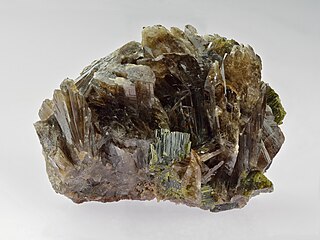
Axinite is a brown to violet-brown, or reddish-brown bladed group of minerals composed of calcium aluminium boro-silicate, (Ca,Fe,Mn)3Al2BO3Si4O12OH. Axinite is pyroelectric and piezoelectric.
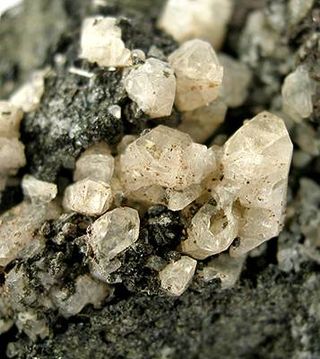
Anorthite is the calcium endmember of the plagioclase feldspar mineral series. The chemical formula of pure anorthite is CaAl2Si2O8. Anorthite is found in mafic igneous rocks. Anorthite is rare on the Earth but abundant on the Moon.

A calcium–aluminium-rich inclusion or Ca–Al-rich inclusion (CAI) is a submillimeter- to centimeter-sized light-colored calcium- and aluminium-rich inclusion found in carbonaceous chondrite meteorites. The four CAIs that have been dated using the Pb-Pb chronometer yield a weighted mean age of 4567.30 ± 0.16 Myr. As CAIs are the oldest dated solids, this age is commonly used to define the age of the Solar System.
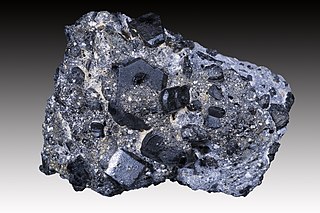
Augite is a common rock-forming pyroxene mineral with formula (Ca,Na)(Mg,Fe,Al,Ti)(Si,Al)2O6. The crystals are monoclinic and prismatic. Augite has two prominent cleavages, meeting at angles near 90 degrees.

Enstatite is a mineral; the magnesium endmember of the pyroxene silicate mineral series enstatite (MgSiO3) – ferrosilite (FeSiO3). The magnesium rich members of the solid solution series are common rock-forming minerals found in igneous and metamorphic rocks. The intermediate composition, (Mg,Fe)SiO
3, has historically been known as hypersthene, although this name has been formally abandoned and replaced by orthopyroxene. When determined petrographically or chemically the composition is given as relative proportions of enstatite (En) and ferrosilite (Fs) (e.g., En80Fs20).

Hedenbergite, CaFeSi2O6, is the iron rich end member of the pyroxene group having a monoclinic crystal system. The mineral is extremely rarely found as a pure substance, and usually has to be synthesized in a lab. It was named in 1819 after M.A. Ludwig Hedenberg, who was the first to define hedenbergite as a mineral. Contact metamorphic rocks high in iron are the primary geologic setting for hedenbergite. This mineral is unique because it can be found in chondrites and skarns (calc–silicate metamorphic rocks). Since it is a member of the pyroxene family, there is a great deal of interest in its importance to general geologic processes.
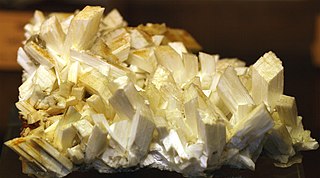
Laumontite is a mineral, one of the zeolite group. Its molecular formula is Ca(AlSi2O6)2 · 4H2O, a hydrated calcium-aluminium silicate. Potassium or sodium may substitute for the calcium but only in very small amounts.

Clinozoisite is a complex calcium aluminium sorosilicate mineral with formula: Ca2Al3(Si2O7)(SiO4)O(OH). It forms a continuous solid solution series with epidote by substitution of iron(III) in the aluminium (m3 site) and is also called aluminium epidote.

Pyroxferroite (Fe2+,Ca)SiO3 is a single chain inosilicate. It is mostly composed of iron, silicon and oxygen, with smaller fractions of calcium and several other metals. Together with armalcolite and tranquillityite, it is one of the three minerals which were discovered on the Moon. It was then found in Lunar and Martian meteorites as well as a mineral in the Earth's crust. Pyroxferroite can also be produced by annealing synthetic clinopyroxene at high pressures and temperatures. The mineral is metastable and gradually decomposes at ambient conditions, but this process can take billions of years.
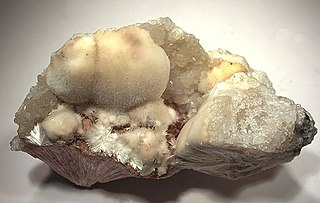
Xonotlite, or eakleite, is a mineral of general formula Ca6Si6O17(OH)2 named by the German mineralogist Karl Friedrich August Rammelsberg in 1866. The name originates from its discovery locality, Tetela de Xonotla, Puebla, Mexico. Although it was discovered in 1866, it was first described in 1959. It is approved by the IMA, but it is a grandfathered species, meaning the name supposedly represents a valid species til this day.
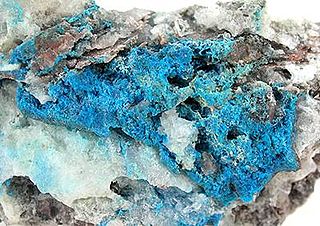
Papagoite is a rare cyclosilicate mineral. Chemically, it is a calcium copper aluminium silicate hydroxide, found as a secondary mineral on slip surfaces and in altered granodiorite veins, either in massive form or as microscopic crystals that may form spherical aggregates. Its chemical formula is Ca Cu Al Si2O6(O H)3.

Pigeonite is a mineral in the clinopyroxene subgroup of the pyroxene group. It has a general formula of (Ca,Mg,Fe)(Mg,Fe)Si2O6. The calcium cation fraction can vary from 5% to 25%, with iron and magnesium making up the rest of the cations.

Aluminosilicate minerals are minerals composed of aluminium, silicon, and oxygen, plus countercations. They are a major component of kaolin and other clay minerals.
Majorite is a type of garnet mineral found in the mantle of the Earth. Its chemical formula is Mg3(MgSi)(SiO4)3. It is distinguished from other garnets in having Si in octahedral as well as tetrahedral coordination. Majorite was first described in 1970 from the Coorara Meteorite of Western Australia and has been reported from various other meteorites in which majorite is thought to result from an extraterrestrial high pressure shock event. Mantle derived xenoliths containing majorite have been reported from potassic ultramafic magmas on Malaita Island on the Ontong Java Plateau Southwest Pacific.
Grossite is a calcium aluminium oxide mineral with formula CaAl4O7. It is a colorless to white vitreous mineral which crystallizes in the monoclinic crystal system.
Dmitryivanovite is a natural mineral composed of calcium, aluminium and oxygen, with the molecular formula CaAl2O4. It was reported in 2009 in a calcium-aluminium-rich inclusion in the carbonaceous chondrite meteorite 470 (NWA470) CH3, which landed in North Africa. The mineral name was chosen to honor Dmitriy A. Ivanov (1962–1986), a geologist, mineralogist, and petrologist who died on a field expedition.
Panguite is a type of titanium oxide mineral first discovered as an inclusion within the Allende meteorite, and first described in 2012.

Ferrogedrite is an amphibole mineral with the complex chemical formula of ☐Fe2+2(Fe2+3Al2)(Si6Al2)O22(OH)2. It is sodium and calcium poor, making it part of the magnesium-iron-manganese-lithium amphibole subgroup. Defined as less than 1.00 apfu (atoms per formula unit) of Na + Ca and consisting of greater than 1.00 apfu of (Mg, Fe2+, Mn2+, Li) separating it from the calcic-sodic amphiboles. It is related to anthophyllite amphibole and gedrite through coupled substitution of (Al, Fe3+) for (Mg, Fe2+, Mn) and Al for Si. and determined by the content of silicon in the standard cell.
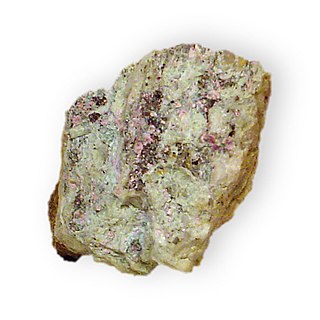
Alumohydrocalcite (IMA symbol: Ahcal) is a calcium aluminium carbonate mineral with the chemical formula CaAl2(CO3)2(OH)4·4H2O). Its type locality is Khakassia, Russia.

Crandallite is a calcium aluminium basic phosphate mineral. It has ideal formula CaAl
3(PO
4)
2(OH)
5·H
2O. Crandallite was named after Milan L. Crandall, Jr, who worked for Knight Syndicate. This mineral is found in laterite and in alteration products of phosphate rich pegmatites.
References
- ↑ Warr, L.N. (2021). "IMA–CNMNC approved mineral symbols". Mineralogical Magazine. 85 (3): 291–320. Bibcode:2021MinM...85..291W. doi: 10.1180/mgm.2021.43 . S2CID 235729616.
- ↑ Krotite, Mindat.org
- 1 2 3 Ma, Chi; Kampf, Anthony R.; Connolly Jr., Harold C.; Beckett, John R.; Rossman, George R.; Sweeney Smith, Stuart A.; Schrader, Devin L. (2011). "Krotite, CaAl2O4, a new refractory mineral from the NWA 1934 meteorite". American Mineralogist. 96 (5–6): 709–715. Bibcode:2011AmMin..96..709M. doi:10.2138/am.2011.3693. S2CID 8236133.
- ↑ "Honolulu, Hawaii news, sports & weather - KITV Channel 4".
- ↑ P. A. Williams; et al. (2010). "New minerals approved by the IMA-CNMNC in September 2010" (PDF). Mineralogical Magazine. 74 (5): 899–902. doi:10.1180/S0026461X00056036. S2CID 232394841.
- 1 2 Martel, Linda (May 6, 2011), Discovery of New Mineral, Krotite, in a CAI, Planetary Science Research Discoveries, CosmoSparks Report
- ↑ Paper announces discovery of 1 of earliest minerals formed in solar system, Eurekalert, May 6, 2011